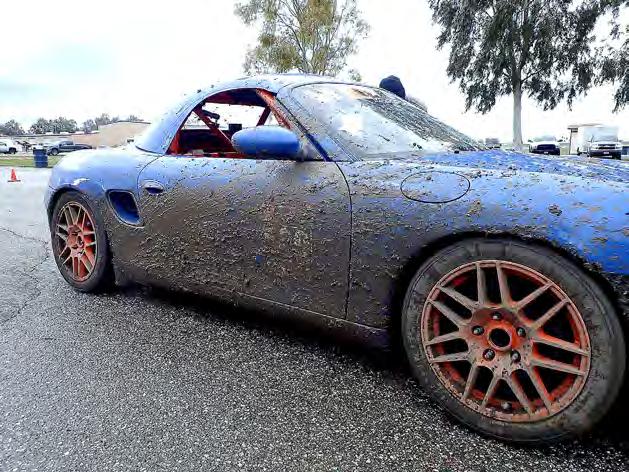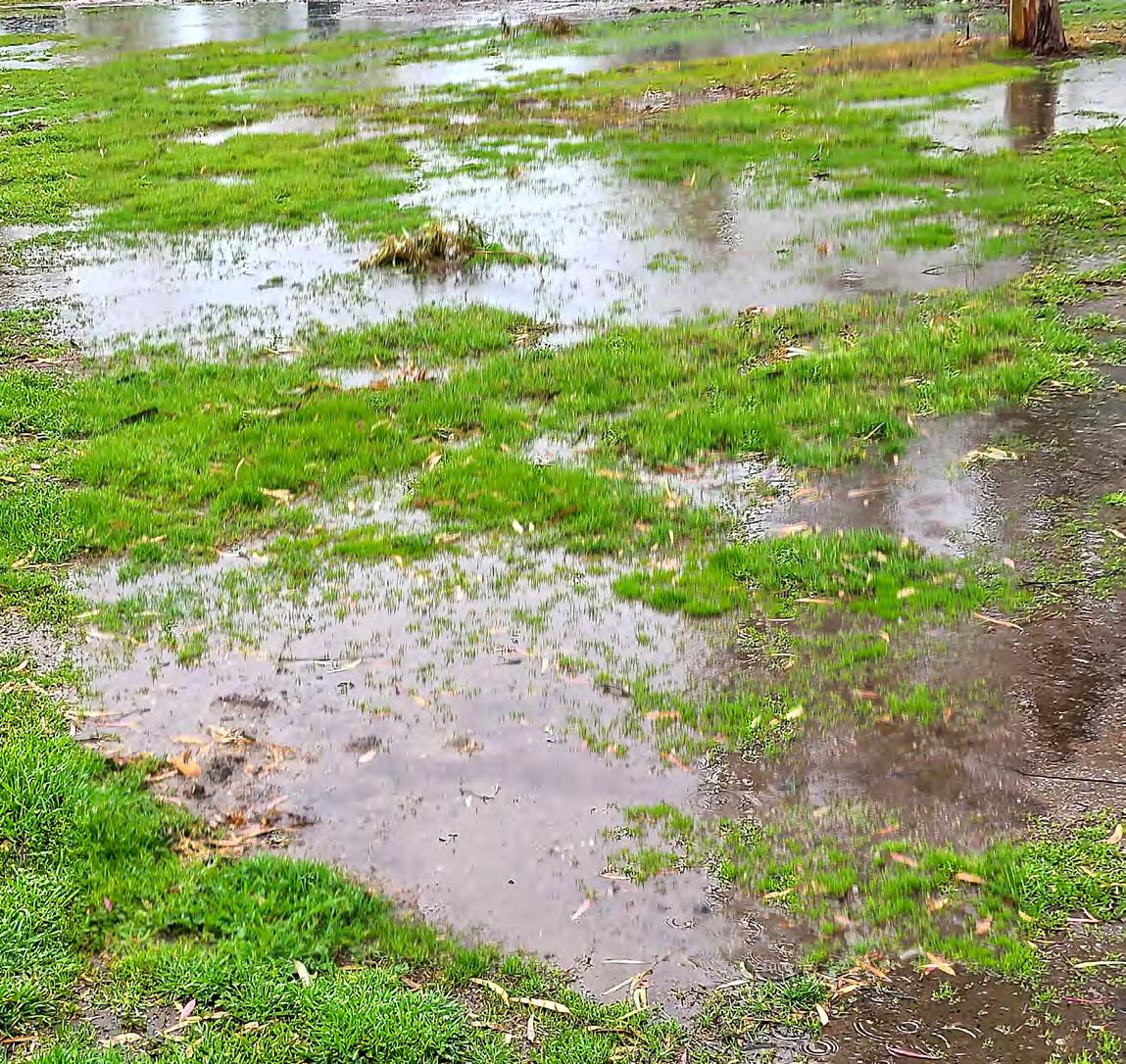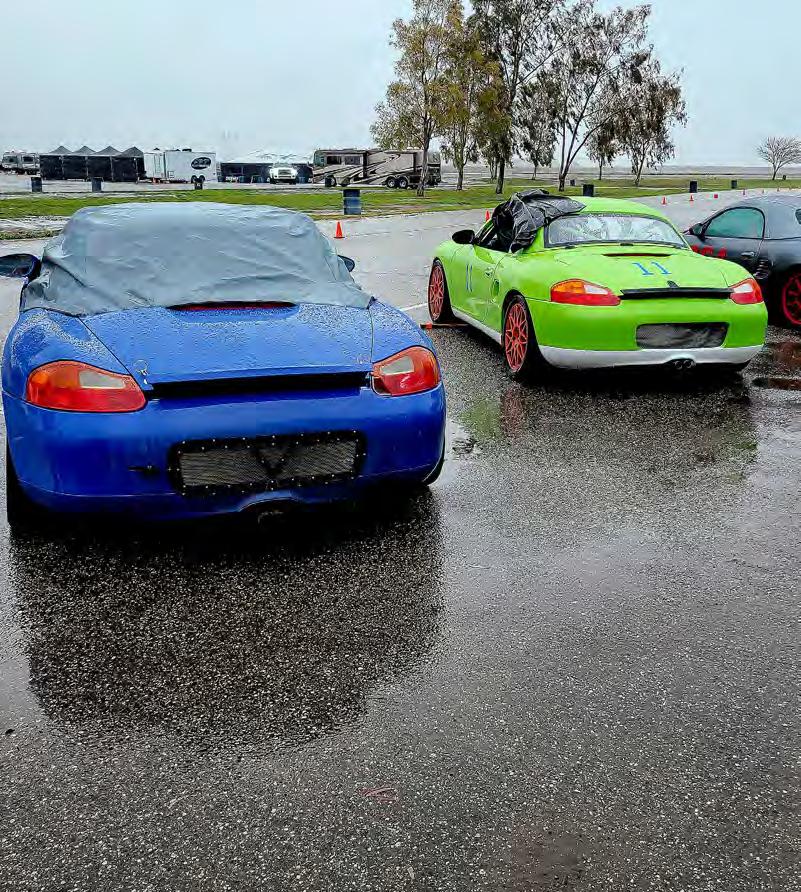
5 minute read
TIME TRIALS IN THE RAIN

Buttonwillow Retrospective
Steve Eisler
When I was in my 20’s and learning to ski on the Advanced slopes, my friends used to say, “If you are not falling, you are not learning.” To a certain extent the same principle applies to driving, “If you’re not spinning, you’re not winning.” Off-track excursions are essential to finding the limits of your driving ability if you don’t make a habit of stirring up the dirt.
At the POC races, Time Trial, and PDS at Buttonwillow last month, staying on track was complicated by an added variable – rain. Not only did the rain make it harder to stay on track, but Buttonwillow is built on exceptionally soft, silty soil that turns into clay when it gets wet. Most cars that got too far off track had to be towed out of the clay. Some got into the lakes that had formed in the infield and sunk so far into the goop that water was coming into the cockpit from under the doors. We arrived and unloaded in clear weather on Thursday afternoon, but it began raining Thursday night. When we returned Friday morning for the Buttonwillow Open Test Day it was still raining, and the showers continued all day. The track was open from 9:00 am, and I was one of the first cars on the track. The traffic was light most of the day, and everyone was very courteous when passing, but there were puddles on the track all day long. This was my third opportunity to learn to drive in the rain, and I took advantage of it by driving a total of 37 laps on Friday.
I knew to stay off the gaters, since the paint makes them slippery, and to use the color of the pavement to determine where the track is the driest. Dealing with puddles and running water across the track was a learning experience. I did not want to hydroplane in the deep puddles but I did try driving through the edge of the puddles with two wheels closest to the puddle but that unsettled the car, so I ended up avoiding all standing water. This was very difficult at the entry to the Esses. As you exit the Star Mazda turn and accelerate towards the first gater on the left there was a puddle (sometimes a small stream) running across the track at the up-shift point. Initially I was breaking at this point but, I gradually increased my speed, and found the best placement for my car to pass through the obstacle. In my limited experience I learned to adjust my line to the track conditions, keep adjusting to see where the track has the most grip, and increase speed gradually as I learned the new line. I also learned to begin braking earlier, and less aggressively to avoid skidding or activating the ABS.
When the POC group hit the track on Saturday morning, the track was almost dry. You still had to be mindful of the water features, one at the exit of Sunset, another in the inside of the Off Ramp. There was a substantial lake inside the Riverside turn, and one awfully close to the right side of the track after you crested Phil Hill. There were many other areas that did not have standing water, but you could see thick mud on the edges of the track. If anyone dropped a wheel and managed to get back on track, you needed to avoid clay-like mud they left on the track since it was very slippery!
Top times in the Blue, Point by Passing group, were Angela Avitt –2:05.877, who moved up to the Green Group on Sunday, Ashley Andreoli – 2:12.881 in a Modified 4 BMW, Mathew Welch –
2:12.987 in class Stock 3, and Stephen McClure – 2:13.284 in Stock 4. Also, under 2:15 were Paul Friedman, GT3, 2:14.371, and Shree Khare, Stock 4, 2:14.554. Shree is a new member of POC and was progressing well until a problem caused him to leave early. Another relative newcomer, Mike Quigley, recorded a 2:17.94 in class GT4.
In the Green group, Alexandra Hainer had the fastest time of the day at 1:49.927 in her GT1 car.
Rennick Palley, in GT2, started the weekend at 2:02.711, and improved in four sessions, finishing with a 1:55.421; just ahead of Prototype driver Matt Price 1:55.428. There were close battles in the Modified 2 class. Jonathan Golden had a best time of 1:57.809, followed by Mike Avitt --1:58.512, and Jim Hall II –1:58.593.
Thirty-eight drivers scored Time Trial points on the wet Buttonwillow track. Some had short excursions into the mud, some had to be pulled out of the ponds, and most of us stayed clean all weekend. The important lesson was to learn to drive in a variety of track conditions. Time Trialing is a great way to experience high performance automotive engineering with a minimum risk to you and your car. You should join us at the new super track, Charleston Peak, at Spring Mountain in May





